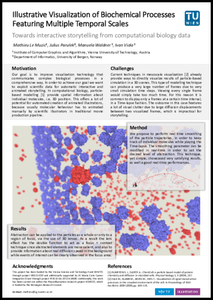Information
- Publication Type: Poster
- Workgroup(s)/Project(s):
- Date: 2014
- Event: Eurographics Workshop on Visual Computing for Biology
- Conference date: 4. September 2014 – 5. September 2014
Abstract
Scientific illustrators are commonly using structural description of molecular compounds when depicting complex biochemical processes. However, computational biology also provides procedural models describing the function of biological processes which are not currently used in the production pipeline. Instead, animators utilize scientific knowledge to manually animate and reproduce the functioning of cellular biology. We would like to explore the use of such models in order to generate explanatory illustrations that would show how molecular machinery works. Particle-based simulations provide the means for spatially representing the dynamics of biochemical processes. They compute the positions of each single particle and are supposed to mimic a realistic behaviour of the metabolites. Current mesoscale visualization also allows to directly show the results of such simulations by mapping the positions of particles in a virtual 3D environment. Nevertheless, some biochemical processes, like the DNA repair for instance, exhibit temporal multiscale aspects because they comprise diffusion rates which are much greater in comparison with reaction rates. As a result, it is challenging to produce a clear and coherent visualization out of this type of simulation. Indeed, when viewing the process at the pace which would let us see the reactions, it becomes impossible for the human eye to keep track of individual elements because of the very large diffusion displacements. On the other hand, if one would playback the simulation slow enough to be see a steady motion of individual elements, then only a very few number of reactions would occur in a reasonable amount of time. In this work we propose to solve the problem associated with multiple temporal scales by providing means for spatial. With this approach we aim at showing the two different temporal scale at the same time by using advanced trajectory smoothing mechanism. This would allow us to see individual elements while showing a world full of reactions, hence enabling us to communicate complex biological processes and molecular machineries in a comprehensive way.Additional Files and Images
Weblinks
No further information available.BibTeX
@misc{lemuzic_2014_ipv,
title = "Illustrative Visualization of Biochemical Processes
Featuring Multiple Temporal Scales",
author = "Mathieu Le Muzic and Julius Parulek and Manuela Waldner and
Ivan Viola",
year = "2014",
abstract = "Scientific illustrators are commonly using structural
description of molecular compounds when depicting complex
biochemical processes. However, computational biology also
provides procedural models describing the function of
biological processes which are not currently used in the
production pipeline. Instead, animators utilize scientific
knowledge to manually animate and reproduce the functioning
of cellular biology. We would like to explore the use of
such models in order to generate explanatory illustrations
that would show how molecular machinery works.
Particle-based simulations provide the means for spatially
representing the dynamics of biochemical processes. They
compute the positions of each single particle and are
supposed to mimic a realistic behaviour of the metabolites.
Current mesoscale visualization also allows to directly show
the results of such simulations by mapping the positions of
particles in a virtual 3D environment. Nevertheless, some
biochemical processes, like the DNA repair for instance,
exhibit temporal multiscale aspects because they comprise
diffusion rates which are much greater in comparison with
reaction rates. As a result, it is challenging to produce a
clear and coherent visualization out of this type of
simulation. Indeed, when viewing the process at the pace
which would let us see the reactions, it becomes impossible
for the human eye to keep track of individual elements
because of the very large diffusion displacements. On the
other hand, if one would playback the simulation slow enough
to be see a steady motion of individual elements, then only
a very few number of reactions would occur in a reasonable
amount of time. In this work we propose to solve the problem
associated with multiple temporal scales by providing means
for spatial. With this approach we aim at showing the two
different temporal scale at the same time by using advanced
trajectory smoothing mechanism. This would allow us to see
individual elements while showing a world full of reactions,
hence enabling us to communicate complex biological
processes and molecular machineries in a comprehensive way. ",
event = "Eurographics Workshop on Visual Computing for Biology",
Conference date = "Poster presented at Eurographics Workshop on Visual
Computing for Biology (2014-09-04--2014-09-05)",
URL = "https://www.cg.tuwien.ac.at/research/publications/2014/lemuzic_2014_ipv/",
}


